A natural progression – Leading for Creative Thinking in Pakistan
Facilitating Creative Leadership Development
Dee Keane CCE Project Lead and Facilitator, Di Fisher-Naylor CCE Associate and Facilitator
CCE’s decade-long partnership with CARE Foundation and Alif Laila in Pakistan has built a strong network of creative school leaders. In 2024, this work entered a new phase, focusing on leadership as the driver of lasting change through Leading for Creative Thinking and the Urdu translation of the Leadership Playbook, supporting a growing global community.
Summary
For over a decade, CCE has worked in close partnership with The CARE Foundation and Alif Laila Book Bus Society in Pakistan to develop and deliver tailored creative learning programmes and associated professional development for educators. This long-standing collaboration has cultivated a strong network of local leaders who now independently adapt and embed creative practices to build the creativity and confidence of the children and young people and the teachers they work with.
As creativity became firmly rooted in both partners’ work, CCE's role shifted to that of being a supportive and curious friend and sharing insights and learning across our wider international network. In 2024, this partnership reached a natural an exciting new phase, grounded in a shared understanding that lasting transformation depends on developing leaders – and that real and sustained change happens when those leaders have the confidence, commitment, and skills to bring others with them. Through CCE’s development of Leading for Creative Thinking we co-developed a professional learning programme, supported the Urdu translation of Creative Thinking in Schools - A Leadership Playbook and continue to develop connections and provide resources, evidence, inspiration and insights through LfCT’s global community and website, marking another significant step in nurturing a new generation of creative leaders.
This story shares CCE’s process, early insights, and the importance of developing creative leaders in embedding creativity, inviting others on a similar journey to connect and grow.
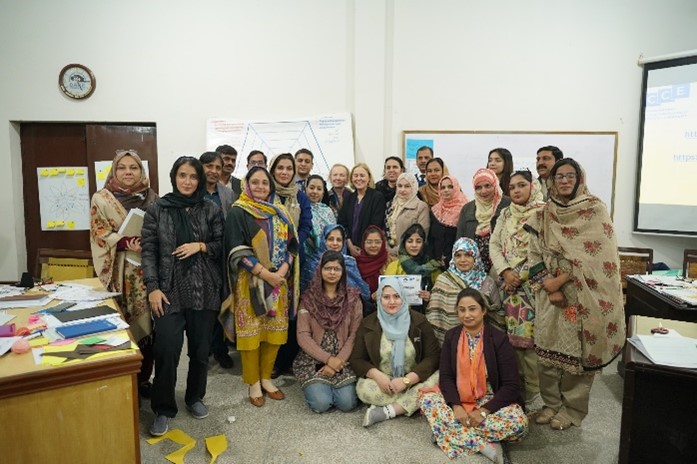
The Development Phase
After dedicated time meeting, collaborating, thinking, planning, drafting, reflecting, navigating uncertainty, and researching, a two-day, in-person Leading for Creative Thinking (LfCT) programme finally took shape. While it was grounded in the Leadership Playbook, we were intentional about introducing new activities to expand the participants’ toolkit. Although there was much we hoped to explore, one of the most valuable insights from this phase was the importance of meeting participants where they were at. We had to be disciplined in our design—protecting time for connection, encouraging playfulness, and embedding “hard fun” through diverse creative experiences which would explore some (but by no means all!) of the key LfCT themes.
As facilitators, we also made a conscious choice to model creative leadership ourselves—incorporating warm-ups and activities that were new even to us, embracing vulnerability and risk-taking alongside the group. By the end of this initial phase, we felt we had crafted a clear narrative—a golden thread running through the two days—that created the conditions for creative leadership to flourish through a facilitated experience during which participants:
- from both partner organisations had time and space to get to know each other as a foundation for building an ongoing professional learning community (PLC)
- could explore and agree the conditions needed to support their successful learning
- could be playful, reflective and collaborative
- explored their own creativity, their experiences and ideas, their leadership strengths and development needs
- creatively explored the concept of leading for creativity drawing on CCE and its partners learning and experiences
- were challenged to lead the learning of other participants by developing and facilitating a creative learning activity
- would be asked to commit to experiment, take risks, share and learn together as a PLC.
Home from home
In December 2024, we travelled to Lahore to co-facilitate the Leading for Creative Thinking programme alongside Muhammad Umair from the CARE Foundation and Amna Hassan Kazmi from Alif Laila.
Before the pandemic, CCE had been a regular presence in Pakistan, but this marked our first visit in nearly five years. While there were some initial nerves on arrival, they quickly gave way to excitement as we spent a full day preparing—setting up our “home from home” in the CARE Foundation’s conference rooms and aligning with the facilitation team ahead of the two-day programme and the arrival of 25 leaders.
Our international work has taught us just how invaluable translators with a deep understanding of creative learning are. In this programme, all activity instructions were thoughtfully translated into Urdu by Umair and Amna, along with participants’ reflections, questions, and responses throughout the sessions. This careful and intentional approach was essential—not only in helping the facilitation team gain deeper insight into participants’ ideas, experiences, concerns and learning needs, but also in ensuring that every voice was truly heard and understood.
And so it began….
Day 1
We began Day 1 with a brief welcome from the team. Keen to get everyone physically active we moved quickly into a playful get to know warmup. Everyone worked in a number of different small groups sharing things they had in common, a leadership strength and a key challenge in leading for creativity. As a whole group they introduced each other sharing what they had learnt about their colleagues, and it was clear that some were already opening up and sharing their personal challenges and vulnerabilities. Our nerves about participants willingness to do this and to be playful were suppressed as they engaged with honesty and energy and at times lots of laughter filled the space. This reminded them of the importance of taking time to get to know people even those we might work with on a regular basis.
Participants then explored their personal perspectives on the conditions necessary for an effective professional learning community. This activity created space for the group to collectively agree on what they should prioritise—and what to avoid doing—over the course of the two days. They also identified what they needed from the facilitation team to best support their learning. The lists which emerged became a valuable touchstone throughout the programme, helping to address emerging issues such as distributing leadership during activities and actively listening to one another. At the same time, they allowed facilitators to highlight moments of leadership strengths —inviting others to contribute, showing bravery, and taking risks. This activity was definitely worth the time it was afforded and participants reflected that this could be readily adapted for their own learning communities.
We felt it was important during Day 1 to explore participants own beliefs about the purpose of school (Note: this is one of the activities in the Playbook). It was interesting to see the key priorities of the partner organisations such as improving the life chances of children and the creative habits emerge as important purposes and values for them as leaders.
Sharing the insights and experiences of other creative leaders is fundamental to our practice at CCE. We’ve been fortunate to collaborate with Lisa Hall, Assistant Head at Cragside Primary School in Newcastle upon Tyne, through our partnership with the North East Creativity Collaborative over the past three years. Lisa joined the session digitally to share her reflections on embedding creative thinking in all aspects of school life. Her emphasis on developing a shared language, making creativity visible (see slide below), and effective communication strategies resonated deeply with the group. The thoughtful questions and comments that followed reflected how her contribution was strengthening participants’ confidence in their own capacity to lead positive change. The richness of the ideas Lisa shared continued to be a strong focus of our ongoing reflective conversations and also helped surface a few key areas the facilitation team needed to address—either in Day 2 or as part of the participants’ future work as a professional learning community.
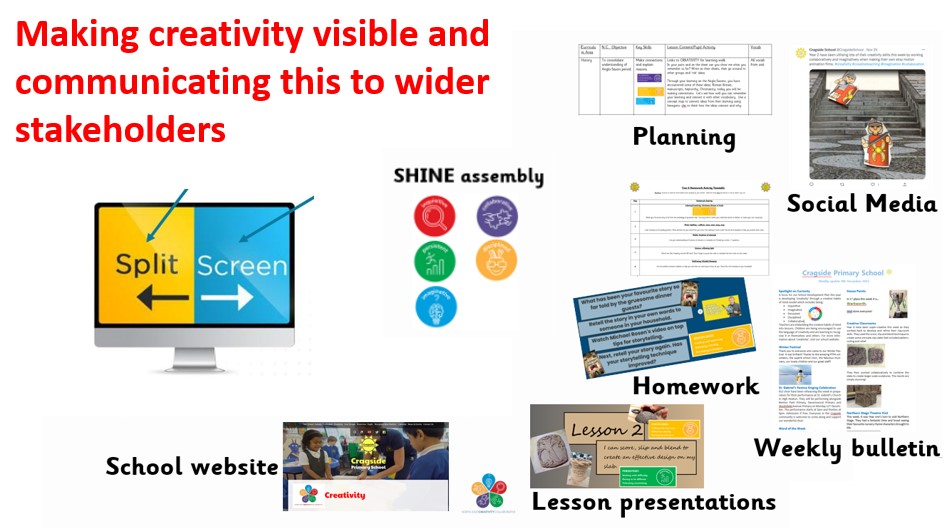
Approaches to making creativity visible: Lisa Hall, Assistant Head, Cragside School, Newcastle upon Tyne, UK
We moved next to “Find the Creative You” an activity which encouraged everyone to reflect on their own capacity to be creative, to notice, highlight, value this and identify which creative habits participants needed to focus on as part of their own development. We did this in the knowledge that believing in one’s own capacity to be creative is fundamental in leading the creativity of others and supporting them to develop creative pedagogies.
We continued with an opportunity to explore the key actions that creative leaders undertake (see Fig 1 below). In small groups, participants created a ‘job description’ for this role—identifying additional skills and qualities it might require and distinguishing between those that were essential and those that were desirable. The activity was carefully designed to unfold in layers, allowing everyone to contribute their thoughts and ideas about the skills and qualities before moving into self-reflection. Participants then completed a self-assessment of their current abilities and potential as creative leaders. Finally, working in pairs participants discussed how to build on their individual starting points and identified what actions they could take to nurture their own leadership qualities and those of the people they support – we would return to this on Day 2.
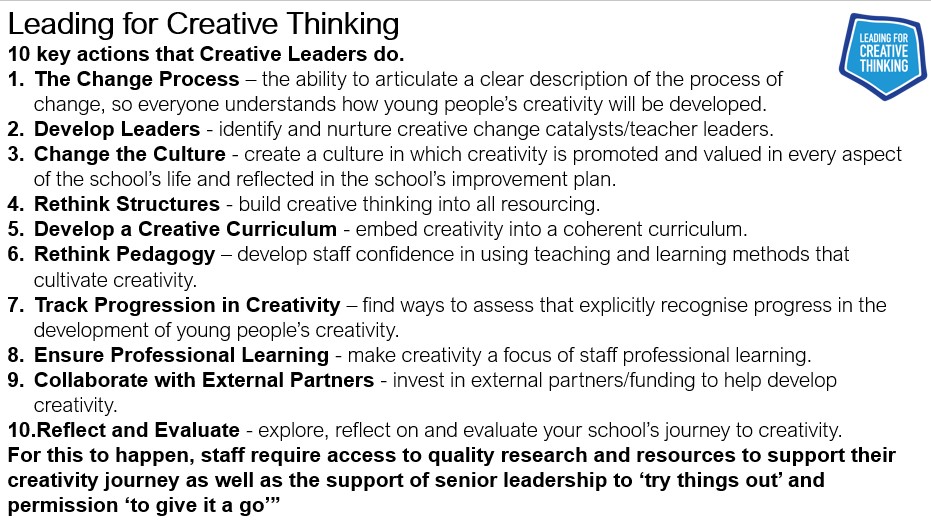
10 key actions that Creative Leaders do.
As promised, we concluded a long and fruitful day on time closing out with brief reflection to capture what participants noticed, liked and would suggest for Day 2 alongside a flipchart exit poll to allow space to reveal important questions, things they didn’t understand and what they would like to learn more about. The facilitation team reviewed this feedback in detail which revealed the need for some overnight re-planning for Day 2 to ensure their needs were met.
Day 2
Umair and Amna began Day 2 with a reflection from the previous day’s learning. We acknowledged and appreciated the valuable contributions and progress made during Day 1 and addressed remaining questions including those around “split screen” learning and signature creative pedagogies. We also highlighted some of the challenges too which required us to revisit the list of conditions for successful learning that we had created together. We had observed a tendency in some small group activities for people to talk over each other, to look to the more confident and outgoing participants to lead and who were also the most eager to share their thoughts, ideas and questions during whole group reflections. To support more balanced participation, we introduced a few simple facilitation strategies drawn from dialogic teaching approaches —such as using “no hands up” and selecting names at random. We reminded everyone that this was a space for bravery, risk taking and shared leadership- that leading takes practice and part of that practice is both inviting others to lead and allowing ourselves to be led, while enjoying the process along the way.
A high energy warmup called “Anyone Who” then got everyone moving, like the one the previous morning this focussed on discovering more about each other. The reflection that followed sparked great ideas about how this activity could be adapted both for professional learning and with children.
We then transitioned into the pivotal session of the morning exploring and developing a Theory of Change. This session centred on one of the 10 Actions Creative Leaders Do (The Change Process) to support participants in practically planning the changes they hoped to see in their schools or networks over the next 18 months, specifically around developing the Creative Habits. As this was a completely new concept for everyone and a critical component of the programme’s overall ambition, we allowed significantly more time to focus on this. Initial reflections revealed some confusion between goals and interventions, so we adjusted the pace to allow participants time to craft and improve their original ideas. We reflected on how the Creative Habits of Persistence (tolerating uncertainty) and Discipline (reflecting critically and crafting and improving) were fundamental in their progress with this challenging task.
Following this, we focused on building participants’ confidence by facilitating an exercise that invited them to reflect on what was already going well in their roles as emerging leaders of creativity—and the role they played in supporting positive change. It was important to acknowledge the momentum they had created and to build on it. We revisited the Theory of Change, this time with a focus on existing structures and interventions already embedded in their schools. A common concern emerged around overburdening teachers with additional tasks, so the conversation naturally shifted toward integration rather than addition. One particularly strong idea that surfaced was the potential for professional learning focused on incorporating Split Screen (subject content alongside creative habits) into existing lesson planning processes.
The afternoon of the final day was time to ‘have a go’ – working in small groups participants were asked to design and facilitate a short creative professional learning activity, alongside experiencing activities designed by others. To support focused planning, we offered some light scaffolding—drawing on our own experience to ensure the groups didn’t spend too long selecting a topic.
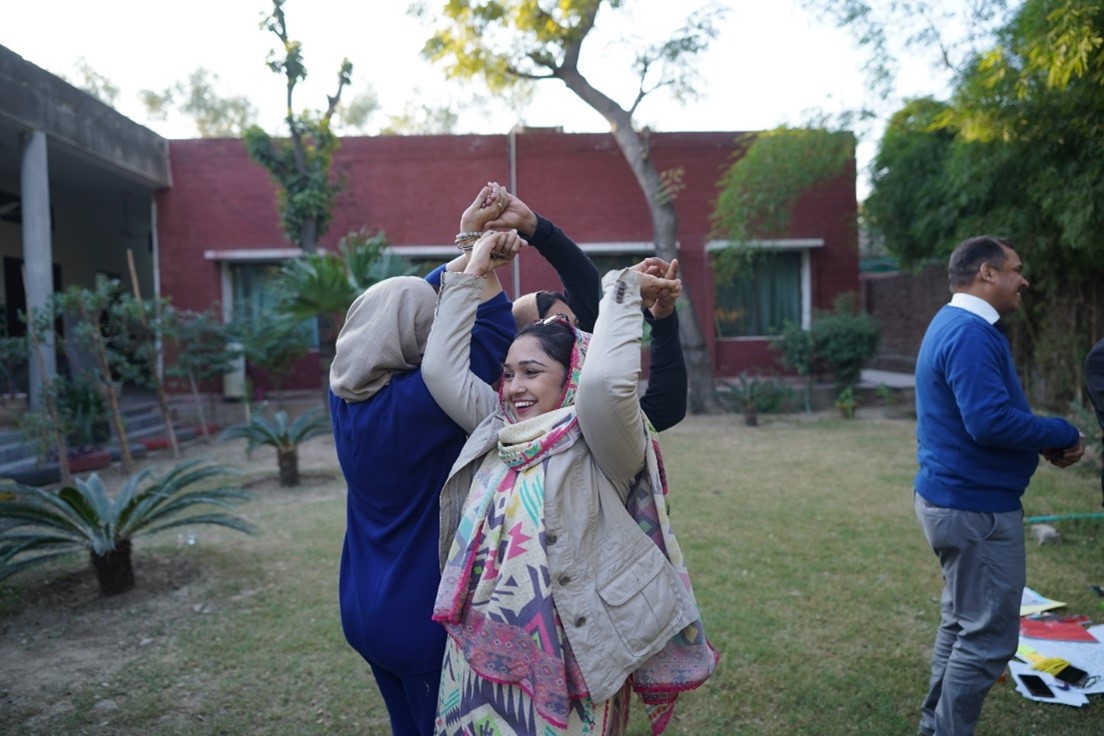
Each group then led 8 of their peers through their short creative professional learning activity. Whilst some were more confidently executed than others, all demonstrated significant and consistent qualities including groups sharing the leading/facilitation, the use of creative pedagogies, active learning and space for reflection. The session ended with small group reflections inviting participants to offer each other positive feedback and identify areas they could build on, as creative leaders.
Our final reflection activity aimed to draw the learning together, to support everyone to identify their professional development needs and make a personal pledge for continued action as leaders of creativity. Each person shared their pledge with the whole group creating a moment of collective affirmation and commitment. We closed with a final reflection on how as a Professional Learning Community (PLC), the group can support one another and keep each other accountable— highlighting the LfCT website and global community with resources, evidence, inspirational events and insights to sustain momentum, purpose and connection beyond the programme.
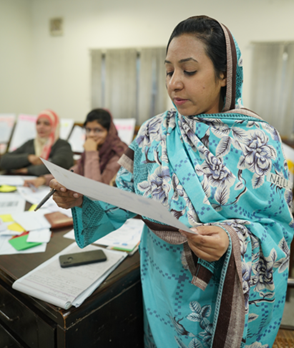
The last word ….from our partners in Pakistan
At CARE, we recognised the need to enhance our leadership capacities to drive transformative change, and the LfCT professional learning programme has been instrumental in helping us achieve this goal.
Through the programme, our team has gained valuable insights into effective leadership practices, strategic planning, and collaborative problem-solving. We have seen significant value in the programme , particularly in the areas of:
- Enhanced leadership confidence and competence
- Improved team collaboration and communication
- Increased ability to analyse complex problems and develop innovative solutions
- Strengthened capacity to drive change and transformation within our organization
We are excited to continue applying the skills and knowledge gained from the LfCT programme to drive meaningful impact in our work.
Muhammed Umair, Team Lead, Development Programmes, The CARE Foundation
We initiated CCE's Leading for Creative Thinking (LfCT) professional learning programme in Pakistan because we deeply understood the importance of developing leaders as the key to transforming education and expanding the impact of our work. From our involvement in the CCE international network, we witnessed first hand the transformative power of this focus on leaders and how it could extend our reach and improve the quality of teaching and learning in schools across Pakistan.
As a facilitator, I firmly believe that fostering innovation, adaptability, and imaginative problem-solving is essential for equipping leaders, educators, and students to thrive in an ever-evolving world. From the outset, the LfCT programme has explored profound insights into how leaders can encourage risk-taking, collaboration, and reflective practices within their teams. I have seen the impact of this work first hand—how addressing systemic gaps can empower leaders and educators with the skills and confidence needed to explore new teaching methods and share their findings across diverse contexts.
We are only at the start of our journey, but we are excited about continuing to learn together, building a strong LfCT professional learning community in Pakistan, and sharing our experiences internationally.
Amna Hassan Kazmi, Chief Executive Officer, Alif Laila Book Bus Society
Our learning
As facilitators we reflect during and after any professional learning programme and our most powerful takeaways from our time in Pakistan were:
- The importance of exposing our own practice and process – democratising what and why we did something as facilitators provided participants with new tools as leaders or learning
- Provide space to learn from another leader of creativity who is open to sharing their journey and the steps along the way – Lisa Hall’s session was powerful, provocative and the focus for much reflection and discussion
- Being willing to adapt in the moment to meet the needs of the participants – going slow
- Modelling a willingness to be vulnerable, to take risks and experiment. We did this ourselves through including a number of new activities, but we also encouraged some participants to lead activities and reflections (this was by far the most powerful!)
- To be bold in returning frequently to the key theories/models particularly during reflections by highlighting/noticing and valuing where the Creative Habits and the 10 Key Actions of Creative Leader were being exercised by participants
- To be clear about next steps: in this case it is important that as a PLC we explore more deeply how to implement split screen thinking and how as leaders we can support teachers to develop a breath of creative pedagogical approaches.
Reflecting Together
- What were the key things you noticed about the facilitation of this Leading for Creative Thinking programme?
- In planning a professional learning day or workshop what are your starting points?
- How has this story influenced your thinking, and what insights are you taking from it?
- What ideas would you be excited to pursue—on your own or with others?
If you would like our support to develop leaders of creative thinking in your schools or our advice and guidance on designing your own professional learning programme, get in touch with us at hello@cceengland.org
